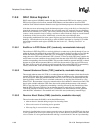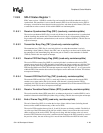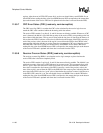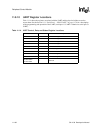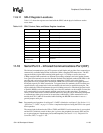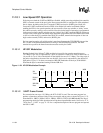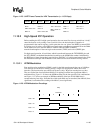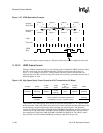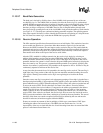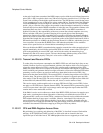
SA-1100 Developer’s Manual 11-103
Peripheral Control Module
11.9.11 SDLC Register Locations
Table 11-15 shows the registers associated with the SDLC and the physical addresses used to
access them.
11.10 Serial Port 2 – Infrared Communications Port (ICP)
The infrared communications port (ICP) operates at half-duplex and provides direct connection to
commercially available Infrared Data Association (IrDA) compliant LED transceivers. The ICP
supports both the original IrDA standard with speeds up to 115.2 Kbps as well as the newer
4-Mbps standard. Both standards use different bit encoding techniques and serial packet formats.
Low-speed IrDA transmission uses the Hewlett-Packard Serial Infrared standard (HP-SIR) for bit
encoding and a universal asynchronous receiver-transmitter (UART) as the serial engine;
high-speed uses four-position pulse modulation (4PPM) and a specialized serial packet protocol
developed expressly for IrDA transmission. To support these two standards, the ICP contains two
separate blocks, each comprised of a bit encoder/decoder and serial-to-parallel data engine. The
engine within the ICP that implements the special 4-Mbps protocol is called the high-speed serial
to parallel (HSSP) receiver-transmitter. Only one of the two standards can be enabled at a time (the
user cannot enable low-speed transmit and high-speed receive at the same time). To support a
variety of IrDA transceivers, both the transmit and receive data pins can be individually configured
to communicate either using normal or inverted data. Additionally, if IrDA transmission is not
needed, the ICP’s UART can be enabled while disabling the HP-SIR bit encoder for use as a
general-purpose serial port.
Note: Programming and operation of serial port 2’s UART is identical to serial port 3. See Section 11.11,
“Serial Port 3 - UART” on page 11-128 for a complete description of using the ICP for low-speed
IrDA operation.
The external pins dedicated to the ICP are TXD2 and RXD2. If serial transmission is not required
and the ICP is disabled, control of these pins is given to the peripheral pin control (PPC) unit for
use as general-purpose input/output pins (noninterruptible). See Section 11.13, “Peripheral Pin
Controller (PPC)” on page 11-184.
Table 11-15. SDLC Control, Data, and Status Register Locations
Address Name Description
0h 8002 0060 SDCR0 SDLC control register 0
0h 8002 0064 SDCR1 SDLC control register 1
0h 8002 0068 SDCR2 SDLC control register 2
0h 8002 006C SDCR3 SDLC control register 3
0h 8002 0070 SDCR4 SDLC control register 4
0h 8002 0074 — Reserved
0h 8002 0078 SDDR SDLC data register
0h 8002 007C — Reserved
0h 8002 0080 SDSR0 SDLC status register 0
0h 8002 0084 SDSR1 SDLC status register 1
0h 8002 0088 –
0h 8002 FFFF
— Reserved




